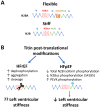Cellular and Molecular Differences between HFpEF and HFrEF: A Step Ahead in an Improved Pathological Understanding
- PMID: 31963679
- PMCID: PMC7016826
- DOI: 10.3390/cells9010242
Cellular and Molecular Differences between HFpEF and HFrEF: A Step Ahead in an Improved Pathological Understanding
Abstract
Heart failure (HF) is the most rapidly growing cardiovascular health burden worldwide. HF can be classified into three groups based on the percentage of the ejection fraction (EF): heart failure with reduced EF (HFrEF), heart failure with mid-range-also called mildly reduced EF- (HFmrEF), and heart failure with preserved ejection fraction (HFpEF). HFmrEF can progress into either HFrEF or HFpEF, but its phenotype is dominated by coronary artery disease, as in HFrEF. HFrEF and HFpEF present with differences in both the development and progression of the disease secondary to changes at the cellular and molecular level. While recent medical advances have resulted in efficient and specific treatments for HFrEF, these treatments lack efficacy for HFpEF management. These differential response rates, coupled to increasing rates of HF, highlight the significant need to understand the unique pathogenesis of HFrEF and HFpEF. In this review, we summarize the differences in pathological development of HFrEF and HFpEF, focussing on disease-specific aspects of inflammation and endothelial function, cardiomyocyte hypertrophy and death, alterations in the giant spring titin, and fibrosis. We highlight the areas of difference between the two diseases with the aim of guiding research efforts for novel therapeutics in HFrEF and HFpEF.
Keywords: cardiomyocyte alterations; endothelial dysfunction; heart failure with preserved ejection fraction; heart failure with reduced ejection fraction; inflammation.
Conflict of interest statement
The authors declare no conflict of interest.
Figures



References
-
- Ambrosy A.P., Fonarow G.C., Butler J., Chioncel O., Greene S.J., Vaduganathan M., Nodari S., Lam C.S., Sato N., Shah A.N., et al. The global health and economic burden of hospitalizations for heart failure: Lessons learned from hospitalized heart failure registries. J. Am. Coll. Cardiol. 2014;63:1123–1133. doi: 10.1016/j.jacc.2013.11.053. - DOI - PubMed
-
- Vedin O., Lam C.S.P., Koh A.S., Benson L., Teng T.H.K., Tay W.T., Braun O.O., Savarese G., Dahlstrom U., Lund L.H. Significance of Ischemic Heart Disease in Patients With Heart Failure and Preserved, Midrange, and Reduced Ejection Fraction: A Nationwide Cohort Study. Circ. Heart Fail. 2017;10 doi: 10.1161/CIRCHEARTFAILURE.117.003875. - DOI - PubMed
-
- Kapoor J.R., Kapoor R., Ju C., Heidenreich P.A., Eapen Z.J., Hernandez A.F., Butler J., Yancy C.W., Fonarow G.C. Precipitating Clinical Factors, Heart Failure Characterization, and Outcomes in Patients Hospitalized With Heart Failure With Reduced, Borderline, and Preserved Ejection Fraction. JACC Heart Fail. 2016;4:464–472. doi: 10.1016/j.jchf.2016.02.017. - DOI - PubMed
Publication types
MeSH terms
LinkOut - more resources
Full Text Sources
Medical
Research Materials
Miscellaneous

